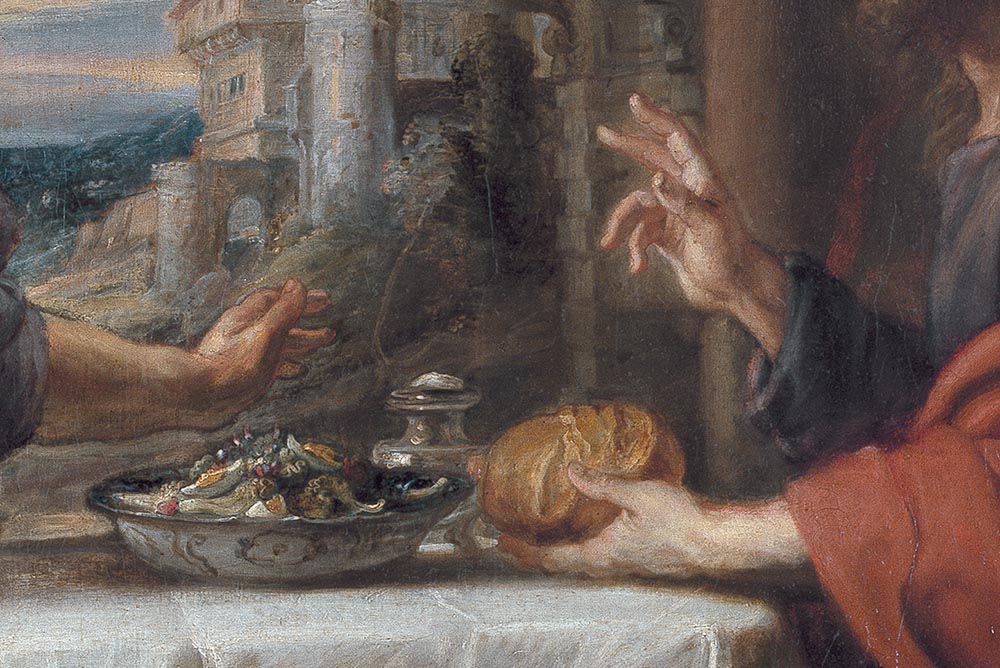
Jesus blesses the bread in a detail from the painting "Supper at Emmaus" (circa 1635-40) by Peter Paul Rubens. (Wikimedia Commons)
Meditating on the story of the healing of Peter's mother-in-law, followed by the immediacy of her "call to serve food," left me thinking about all of the times in the New Testament in which Jesus' encounters with people had to do with food. Was Jesus a "foodie" according to the current definition: a person with an ardent or refined interest in food?
I find that there are, in fact, numerous instances in the New Testament/Christian Bible of Jesus engaged in sharing food with friends, apostles, disciples and followers. Jesus enjoyed food and wine — plenty of it — with a young couple and thirsty followers at the wedding feast of Cana (John 2:1-11). And at the end of John's Gospel, after the miraculous catch of 153 fish and the triple attestation of love by Peter, Jesus cooks and enjoys breakfast with his Apostles (John 21:1-14).
Matthew admits that Jesus experienced hunger after his bout with temptation in the desert (Matthew 4:1-11). With only two barley loaves and two fish, he creates a meal for 5,000, because he was sensitive to their thirst for both knowledge of God and for food (Matthew 14:13-21). (He fed 4,000 in Matthew 15:32-39 and in Mark 8:1-9.)
But Luke seems to have been even more preoccupied with Jesus' food experiences. Jesus shares food with the wrong people, the tax collectors and sinners, at the home of Levi (Luke 5:29-32). He allows himself to be anointed by a woman in the home of Simon the Pharisee during a meal (Luke 7:36-50).
Then Jesus refines the circle, telling of the large banquet to which the poor are invited possibly because friends were too busy (Luke 14:7-24). An unlikely host, Zacchaeus, invited Jesus to join him and his household for a meal (Luke 19:1-10).
The Last Supper was truly a zenith food experience that became the paradigm for all Christian meals (Luke 22:14-20). After the Resurrection, Jesus was still "doing food," for he stayed to have supper with two disciples after the encounter on the road to Emmaus, and, significantly, "they knew him in the breaking of the bread" (Luke 24:13-35).
The interesting thing about Jesus and food is that each of Jesus' food experiences had to do with people and with service. The incarnate Son of God came to earth to let all people know about his Father's kingdom/kindom (through preaching about both realized and future eschatology), and to teach, heal and show everyone who came after him how to live and love. When we examine the aforementioned Gospel texts, it is obvious that Jesus uses familiar foods (grains and mustard seeds), the natural world (fig trees and grapevines), and human experiences (widow's son and woman's lost coin) to make his points.
All of these meals make me wonder: What kinds of foods did people enjoy in the first century C.E.? Surely there was no fast-food MacDonald's, kiwi fruit from Australia, coffee from Hawaii, or cocoa from Africa. People did not have to worry about overeating, for food was actually scarce and seasonal. And achieving food and drink involved knowing how to manage the workings of a water wheel, the strength to carry buckets of water, and the endurance to sift grain or stay up all night with the harvest.
Advertisement
The food shopping list then consisted of grain from the fields, milk and butter from the cows, honey from the bees, eggs from the chickens scratching in the yard, vegetables (beans, lentils, onions, cucumbers), fish (a staple), meat (pork and certain other meats were forbidden by the purity laws), fruit (figs), and nuts. The essential food was bread, so much so that "to share a meal" and "breaking bread" were synonymous in their understanding. It is also interesting that the loaves were usually made round.
Not to be forgotten is the wine, stored in tall jars or kept in wineskins. Vineyards were abundant in Israel in the first century. Rumor had it that Noah was taught by God himself how to make wine.
I am thinking: Is it any wonder that Jesus chose bread and wine when he broke bread at the Last Supper, and when he said the words in John 6, "Unless you eat the flesh of the Son of Man and drink his blood you cannot have eternal life within you"? Of course, these words were shocking — even sacrilegious — to Jews who embraced faithfully their dietary and purity laws of the time, and many walked away.
Alas, sadly, since the first century, food scarcity has not gone away, even in this era of abundance, and planes and trains and trucks to transport "extra food" produced by some nations. In fact, in many countries of the world (including in the United States), people are suffering from hunger, even starvation, while richer countries like ours waste up to 30-40% of their food supply, according to the U.S. Department of Agriculture.
And the pandemic has only multiplied the food insecurities for millions throughout the world, along with climate change destruction and wildfires, with joblessness and homelessness, with COVID-19 deaths and lack of access to vaccinations — with all the issues in our world that we know are intimately connected.
If it is true that Jesus lived in the real world of what we now call early first century, then the spirit of his life in the Gospels is instructive for us. The movie "Mully" continues to inspire me (the rags-to-riches story of Charles Mully, onetime Kenyan business tycoon who founded Mully Children's Family, the largest children's rescue, rehabilitation and development organization in Africa). It demonstrates the ways extremely poor common people can together figure out how to use their resources to feed and humanize the population — as well as create structures to interconnect all the discrete elements of their lives.
I look also to organizations already in existence — like the USDA, as one government organization that is dealing with many of these interconnected issues that collaborate to feed the people living in our common home, like global food supply and security, climate and energy needs, sustainable use of natural resources, nutrition and childhood obesity, food safety, education and science literacy, rural and urban prosperity.
And I ask myself and all of us: Is there some aspect of these global endeavors to which I/we might contribute? It seems that, by doing so, we can live the Gospel messages about Jesus' engagement with food, along with his concern for people and service. These are issues that nourish us while joining others at the table in carrying out the mission of Jesus.






